Questions
Free download in PDF CBSE NTA UGC NET(National Eligibility Test) November 2017 Mass Communication and Journalism paper II.
1. Aurobindo Ghosh’s Journal was :
- (1) Satyavadini
- (2) Dharma
- (3) Swadesimitran
- (4) Bala Bharathi
Answer:(2)
2. __________ are arbitrary, abstract and represent unseen phenomena.
- (1) Symbols
- (2) Signs
- (3) Rules
- (4) Codes
Answer:(1)
Advertisement
3. Priming effect of Leonard Berkowitz focusses on :
- (1) Political manipulations
- (2) Television Violence
- (3) Individualism
- (4) Personal Relations
Answer:(2)
4. Who is the author of the book ‘Pen as my sword’ ?
- (1) K. Rama Rao
- (2) S.K. Rau
- (3) M. Chalapathi Rao
- (4) S. Prakasa Rao
Answer:(1)
5. The information processing theory argues that our cognitive resources are :
- (1) Large
- (2) Superflous
- (3) Limited
- (4) Unreliable
Answer:(3)
6. The positioning of news stories to highlight some aspects of a political issue is known as :
- (1) Frame of reference
- (2) Semantic noise
- (3) Homophily
- (4) Priming
Answer(4):
7. Which folk drama is known for its humour and social criticism ?
- (1) Yakshagana of Karnataka
- (2) Nautanki of Uttar Pradesh
- (3) Kariyala of Himachal Pradesh
- (4) Mohiniyattam of Kerala
Answer:(3)
8. Deliberate manipulation of communication was referred to as :
- (1) Campaigning
- (2) Propaganda
- (3) Advertising
- (4) Gossip
Answer:(2)
9. The concept of structural violence as related to mass communication can be traced to :
- (1) Johann Galtung
- (2) Jacob Thompson
- (3) William Parker
- (4) Mark Pearson
Answer:(1)
10. The lack of access to communication technology among people of different races, the poor, the disabled and the rural communities is known as :
- (1) Group conformity
- (2) Technically savvy
- (3) Group deviance
- (4) Digital divide
Answer:(4)
11. The ‘Copyright day’ is observed on :
- (1) February 01
- (2) October 15
- (3) July 05
- (4) April 23
Answer:(4)
12. Holism refers to :
- (1) Interdependent systems exchange information
- (2) Consists of sub-systems and supra-system affects every other part
- (3) System have boundaries that separate them
- (4) Interpenetrating systems freely exchange information
Answer:(2)
13. Logo is an identifying mark of a :
- (1) Product
- (2) Company
- (3) Person
- (4) Purchaser
Answer:(2)
14. Bernard Berelson developed the research method :
- (1) Content analysis
- (2) Telephone interview
- (3) Action research
- (4) Focus group discussion
Answer:(1)
15. Purposive Sampling is not amenable to :
- (1) Field work
- (2) Testing
- (3) Descriptive statistics
- (4) Inferential statistics
Answer:(4)
16. The textuality of television is considered as :
- (1) Limited
- (2) Indeterminate
- (3) Monosemy
- (4) Inter-textual
Answer:(4)
17. The Limited Effect Theory was developed by :
- (1) Coillion Cowper
- (2) John Abraham
- (3) Elihu Katz
- (4) Joseph Klapper
Answer:(4)
18. In innovation diffusion theory, those who directly influence early adopters are known as :
- (1) Rejectors
- (2) Enforcers
- (3) Commentators
- (4) Change agents
Answer:(4)
19. DPA is a news agency of __________.
- (1) Spain
- (2) Sweden
- (3) Finland
- (4) Germany
Answer:(4)
20. Identify the scale which is simply a system of assigning numbers to events :
- (1) Ordinal scale
- (2) Internal scale
- (3) Nominal scale
- (4) Ratio scale
Answer:(3)
21. E.M. Rogers’ work of ‘diffusion of innovations’ illustrates the power of :
- (1) Meta-analysis
- (2) Content analysis
- (3) Group analysis
- (4) Cognitive effects
Answer:(1)
22. Most commonly used method specially in studies relating to behavioural sciences :
- (1) Observation Method
- (2) Survey Method
- (3) Interview Method
- (4) Content Analysis Method
Answer:(1)
23. “The need for decolonisation and democratisation of information and communication” was propagated by :
- (1) The New World Information and Communication Order (NWICO)
- (2) Monopoly of broadcasting
- (3) The Marxist Theory of Media and Society
- (4) Copyright Policies
Answer:(1)
24. The term, objectivity rituals, is used in :
- (1) News reporting
- (2) Public relations
- (3) Advertising
- (4) Cultural communication
Answer:(1)
25. Identify one of the key recommendations of the First Press Commission :
- (1) Setting up of the office of Registrar of Newspapers of India
- (2) Abolition of Press Council of India
- (3) Introduction of Article 19 (1) (A)
- (4) Special privileges to newspaper owners
Answer:(1)
26. Assertion (A) : The do-it-yourself digital tools offer an audience public control over media environment.
Reason (R) : The dominant media models are resorting to unbridled supply of frivolous entertainment to survive.
Code :
- (1) Both (A) and (R) are true.
- (2) Both (A) and (R) are true, but (R) is not the correct explanation of (A).
- (3) (A) is true, but (R) is false.
- (4) (A) is false, but (R) is true.
Answer:(1)
27. Assertion (A) : Editorial neutrality and political detachment are a great journalistic tradition.
Reason (R) : Partisan media systems result in an alliance between a section of the media
and government, which is a positive result.
Code :
- (1) Both (A) and (R) are true.
- (2) Both (A) and (R) are true, but (R) is not the correct explanation of (A).
- (3) (A) is true, but (R) is false.
- (4) (A) is false, but (R) is true.
Answer:(3)
28. Assertion (A) : There have been fast paced shifts in media management paradigms all over the world.
Reason (R) : The emergence of new semiotic socio-political order has affected the media economics to a large extent.
Code :
- (1) Both (A) and (R) are true.
- (2) Both (A) and (R) are true, but (R) is not the correct explanation of (A).
- (3) (A) is true, but (R) is false.
- (4) (A) is false, but (R) is true.
Answer:(1)
29. Assertion (A) : The mainstream media managers have now lost the way to hold their audiences intact.
Reason (R) : For, in the new socio-technical world, audiences produce their own contents and meanings.
Code :
- (1) Both (A) and (R) are true
- (2) Both (A) and (R) are true, but (R) is not the correct explanation of (A).
- (3) (A) is true, but (R) is false.
- (4) (A) is false, but (R) is true.
Answer:(2)
30. Assertion (A) : The convergent technology is transforming the socio-cultural orders all over the world.
Reason (R) : The new media have offered expanded options for the users to experiment with.
Code :
- (1) Both (A) and (R) are true.
- (2) Both (A) and (R) are true, but (R) is not the correct explanation of (A).
- (3) (A) is true, but (R) is false.
- (4) (A) is false, but (R) is true.
Answer:(1)
31. Assertion (A) : The distinctions among different media are getting erased fast.
Reason (R) : The convergent digital technology has made the hybrid media possible.
Code :
- (1) Both (A) and (R) are true.
- (2) Both (A) and (R) are true, but (R) is not the correct explanation of (A).
- (3) (A) is true, but (R) is false.
- (4) (A) is false, but (R) is true.
Answer:(1)
32. Assertion (A) : The counter-hegemonic media practices will be marginalised in due course.
Reason (R) : It is to neutralise the threat they pose to the established media order.
Code :
- (1) Both (A) and (R) are true.
- (2) Both (A) and (R) are true, but (R) is not the correct explanation of (A).
- (3) (A) is true, but (R) is false.
- (4) (A) is false, but (R) is true.
Answer:(1)
33. Assertion (A) : The Indian film industry represents a splintered semiotics of inter-cultural integration.
Reason (R) : Films in India frequently project sub-cultural themes to exhibit identity integration.
Code :
- (1) Both (A) and (R) are true.
- (2) Both (A) and (R) are true, but (R) is not the correct explanation of (A).
- (3) (A) is true, but (R) is false.
- (4) (A) is false, but (R) is true.
Answer:(2)
34. Assertion (A) : The issue of hyphenated identities dot the discourse of new international information and communication order.
Reason (R) : The issues of identity and culture often work against cultural homogenisation prompted by Western media.
Code :
- (1) Both (A) and (R) are correct.
- (2) Both (A) and (R) are correct, but (R) is not the correct explanation of (A).
- (3) (A) is true, but (R) is false.
- (4) (A) is false, but (R) is true.
Answer:(2)
35. Assertion (A) : Mutual understanding forms the basis of an open, two-way communication in Public Relations.
Reason (R) : For, it enables an organisation to influence public opinion, public judgement and public behaviour.
Code :
- (1) Both (A) and (R) are true.
- (2) Both (A) and (R) are true, but (R) is not the correct explanation of (A).
- (3) (A) is true, but (R) is false.
- (4) (A) is false, but (R) is true.
Answer:(1)
36. Find out the correct chronological sequence of the following Newspapers.
- (1) Forward, Bombay Chronicle, Swarajya, National Herald
- (2) National Herald, Bombay Chronicle, Swarajya, Forward
- (3) Bombay Chronicle, Swarajya, Forward , National Herald
- (4) Swarajya, National Herald, Forward, Bombay Chronicle
Answer:(3)
37. Identify the correct Chronological sequence of the following television networks.
- (1) Rupavahini, STAR, Zee TV, Al Jazeera
- (2) STAR, Zee TV, Al Jazeera, Rupavahini
- (3) Zee TV, Al Jazeera , Rupavahini, STAR
- (4) Al Jazeera, Rupavahini, STAR, Zee TV
Answer:(1)
38. Write the correct sequence of the following top magazines of the world.
- (1) Time, Reader’s Digest, Cosmopolitan, National Geographic
- (2) Reader’s Digest, Cosmopolitan, National Geographic, Time
- (3) Cosmopolitan, National Geographic, Time, Reader’s Digest
- (4) National Geographic, Time, Reader’s Digest, Cosmopolitan
Answer:(2)
39. Find out the correct chronological sequence of the following films.
- (1) Sita Bibaha, Joymati, Kalidas, Ayodyacha Raja
- (2) Kalidas, Ayodyacha Raja, Joymati, Sita Bibaha
- (3) Ayodyacha Raja, Joymati, Sita Bibaha, Kalidas
- (4) Joymati, Sita Bibaha, Ayodyacha Raja, Kalidas
Answer:(2)
40. Identify the sequence of the following research studies.
- (1) Communication and perception, War propaganda, experiments in mass communication, voter studies
- (2) War propaganda, experiments in mass communication, voter studies, communication and perception
- (3) Voter studies, War propaganda, experiments in mass communication, communication and perception
- (4) Experiments in mass communication, communication and perception, voter studies, War propaganda
Answer:(3)
41. Match the following :
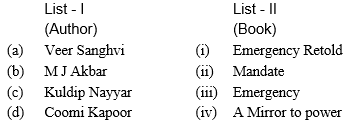
Code :
- (1) (ii) (iv) (i) (iii)
- (2) (iv) (i) (iii) (ii)
- (3) (i) (ii) (iii) (iv)
- (4) (ii) (iii) (iv) (i)
Answer:(1)
42. Match the following :
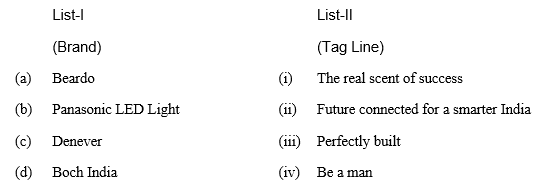
- (1) (iv) (iii) (i) (ii)
- (2) (iii) (iv) (ii) (i)
- (3) (i) (ii) (iv) (iii)
- (4) (ii) (i) (iii) (iv)
Answer:(1)
43. Match List-I with List-II :
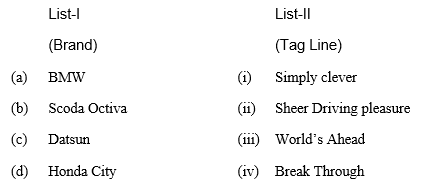
- (1) (ii) (i) (iv) (iii)
- (2) (i) (ii) (iii) (iv)
- (3) (iv) (iii) (i) (ii)
- (4) (iii) (iv) (ii) (i)
Answer:(1)
44. Match List-I with List-II :
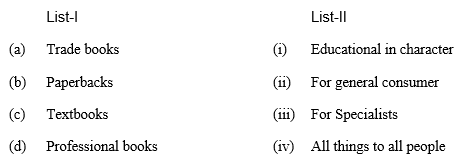
- (1) (ii) (iv) (i) (iii)
- (2) (iii) (ii) (iv) (i)
- (3) (ii) (i) (iv) (iii)
- (4) (iv) (iii) (ii) (i)
Answer:(1)
45. Match the following tag line :
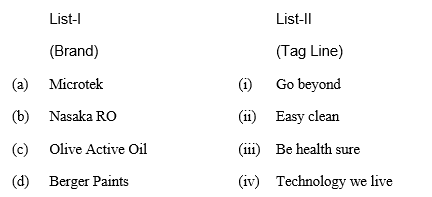
- (1) (ii) (iv) (i) (iii)
- (2) (i) (ii) (iii) (iv)
- (3) (iv) (iii) (i) (ii)
- (4) (iii) (i) (iv) (ii)
Answer:(3)
46. What was the issue related to the proliferation of media in the early twentieth century ?
- (1) Media reach
- (2) Social impact
- (3) Passive excitement
- (4) Competition among media
Answer:
47. The Geneva Convention wanted the promotion of educational films to :
- (1) Export them
- (2) Import them
- (3) Encourage their circulation
- (4) Support moral disarmament
Answer:(4)
48. The 1924 International Convention made the declaration that the trade and public exhibition of obscene matters are :
- (1) A punishable offence
- (2) A transient phenomenon
- (3) To be exempted from customs duty
- (4) Artistic representations
Answer:(1)
49. What was the other concern of the Convention ?
- (1) Emphasis on traditional forms of silent diplomacy
- (2) Use of newspapers for communication
- (3) Use of media as instruments of diplomacy
- (4) Understanding the new forms of media
Answer:(3)
50. The passage has an over-all description of mass media’s :
- (1) Role for peaceful purposes
- (2) Adoption of important treaties
- (3) Use for educational communication
- (4) Positive as well as negative use
Answer:(4)
UGC NET Mass Communication and Journalism November 2017 Paper III
Take Mock Tests




